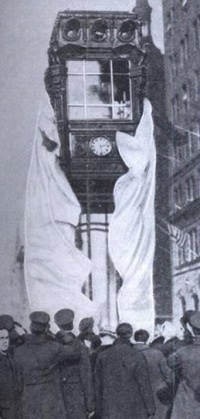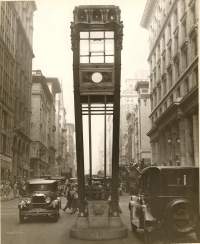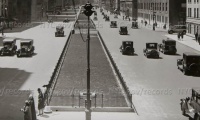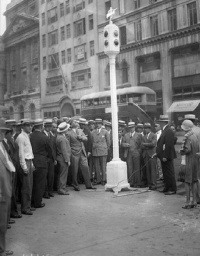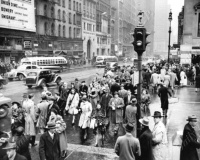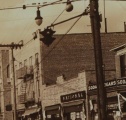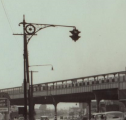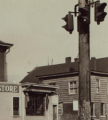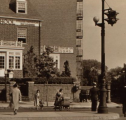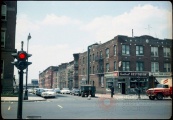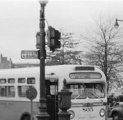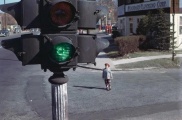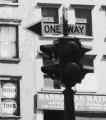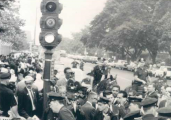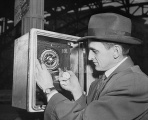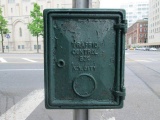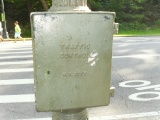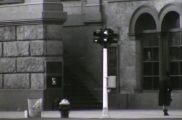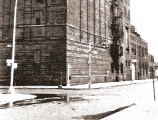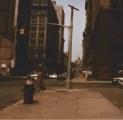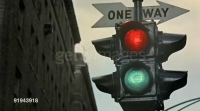Difference between revisions of "New York City Intersections"
(→Traffic signal configurations) |
(→Traffic signal configurations) |
||
| Line 83: | Line 83: | ||
'''Angled Signal Sections''' | '''Angled Signal Sections''' | ||
| − | These were of another kind, in which were adequate to use at skewed intersections in New York City. Sometimes, at such an intersection, both | + | These were of another kind, in which were adequate to use at skewed intersections in New York City. Sometimes, at such an intersection, both kinds were used. Either in different heads that were in use or just only one. |
<gallery mode="nolines" widths=200px> | <gallery mode="nolines" widths=200px> | ||
Revision as of 08:22, 17 February 2014
This page is under construction.
Contents
The 1920s
Traffic control towers
Throughout New York City, various intersections (those that were typically major) were controlled mainly by either police officers or traffic control towers. With regards to traffic control towers, these were generally operated by police officers and red and green and red, amber, and green sets were in use. One kind of traffic control tower that is well known to date is the bronze tower, in which was designed by Joseph H. Freedlander and first unveiled by the 5th Av. Association in 1922. Approximately seven were installed on one segment of the major thoroughfare, and these were in use throughout the 1920s. The decorative design of the tower stood out the most, since Freedlander strongly believed in aesthetics. At the top, a police officer was stationed within the inside, and a set of red, amber, and green signal indications were in use.
While the bronze towers were able to provide adequate traffic control, there were some disadvantages. One to point out is the placement of the tower. The ideal spot at an intersection for this tower was the middle, and this eventually proved to be an obstacle for motorists that wanted to make left and right turns at intersections. Another disadvantage to take into consideration is the use of the amber indication. Though it indicates to motorists to slow down and come to a full stop, many motorists were rather confused by the indication and either tried to speed up to clear the intersection or stopped too early, in which either situation sometimes resulted in a bad accident. A solution to alleviate these common issues was necessary.
First traffic signals
By the mid 1920s, New York City's police department introduced the first automatically-controlled traffic signals. These first appeared in the boroughs of Brooklyn and Manhattan, and they would soon spread to the rest of the other boroughs in the following decade. The new traffic signals, in which were manufactured by the Ruleta company, showed red and green signal indications to motorists, and this became a permanent standard for New York City traffic signals. Ultimately, the amber signal indication was abandoned. The police department's new system of traffic signals were synchronized, in which were intended for an ideal flow of traffic, and various precincts throughout the city had control centers for police officers to manually adjust signal timing (if necessary).
The earliest traffic signals in New York City were commonly attached to unusually tall pedestals, and solely one was in use at a major intersection. In later years, most, if not all, were either modified or removed from service.
Original form of caution
Because the traffic signals showed red and green signal indications to motorists, the original form of caution was what is commonly know as a "dark-out period." Both signal indications appeared unlit in between 1 to 3 seconds before the red signal indication then appeared lit. A red clearance then typically followed prior to when the other direction changed from red to green.
Decline of the traffic control tower
As traffic signals began to appear at more locations throughout the city, the ultimate removal of traffic control towers took place at the of end of the 1920s. This includes the seven bronze towers of 5th Avenue in Manhattan. Regarding these in particular, none were saved and preserved when the removal process took place at this time. Even so, an original model of Joseph H. Freedlander's traffic control tower is in the hands of a private collector today, while a replica of this is on display at the Museum of the city of New York. This is true for his original designs of the bronze tower as well.
Bronze signal
In 1929, the 5th Avenue Association planned to install a new set of traffic signals for one segment of 5th Avenue. As a result, Joseph H. Freedlander was asked to design a traffic signal, and the bronze signal was born. Manufactured by General Electric, the traffic signal was decorative, and a total of four sides were in use for red and green signal indications. Though most signal indications lacked actual cutaway visors, some were attached to these. One noticeable feature of the traffic signal was the statuette of the Roman god Mercury, in which was made of gilded bronze. On July 22nd of 1929, Joseph H. Freedlander's traffic signal was first unveiled and tested at the corner of 5th Avenue and W. 57th Street. In total, 104 would be installed by 1931. From Washington Square Park to W. 59th Street at Central Park.
Golden age
Brief background
The 1930s to 1950s is considered as the golden age of two-section traffic signals in New York City, since they first became widespread in the 1930s and eventually the norm by the 1940s. Traffic signals manufactured by the Ruleta company were heavily in use throughout the boroughs; however, at least two other kinds were in existence in this time period. They are traffic signals from General Electric and Horni (presumably).
Color
In the beginning, with the exception of the G.E. "bronze signals," traffic signals were originally painted black, in which is also true for their pedestals as well. In later years, though, most were repainted dark olive green.
Intersection layout
A classic set-up at an intersection in New York City had two traffic signals at two corners. It was, by far, the most common set-up throughout the boroughs in this time period. The configuration was rather simple, and one traffic signal was located diagonally across from the other. Each one at a corner. A fixed four-way traffic signal was typically in use, and each head was generally mounted to its own pedestal, in which was manufactured by Union Metal.
Aside from this popular set-up, other arrangements at intersections were in existence as well, due to some factors, such as location and complexity, and, though many traffic signals were attached to pedestals, others were suspended as well. For this set-up in particular, typically only one suspended head controlled an entire intersection.
Mounting configurations
Below, are a handful of various mounting configurations that were in use in different areas of New York City in the early 20th century.
Traffic signal configurations
In the time of the golden age, amongst two-section traffic signals were several different common configurations on the streets, in which each one had its own purpose. Below, are photographs that show these in use in New York City.
Louvers
This first set shows the use of the square louvers. They were compatible with fixed four-way and individual traffic signals from Ruleta. It was a common practice to use these at signalized intersections that were generally skewed.
Angled Signal Sections
These were of another kind, in which were adequate to use at skewed intersections in New York City. Sometimes, at such an intersection, both kinds were used. Either in different heads that were in use or just only one.
Long Tunnel Visors
Though this was uncommon, long tunnel visors were used in later years on two-section traffic signals. This was typically a result of a modification at an intersection.
Short visors
Often times, a traffic signal that was extremely close to a curb at an intersection typically had one pair of short visors attached to it. With the case of a fixed four-way traffic signal, the side that faced the curb of a corner had the set installed. This is true for individual heads as well. Overall, the simple purpose behind these short visors was to prevent damage by a large vehicle making a turn at the corner.
Blank doors
These were common amongst fixed four-way Ruleta traffic signals, and they typically covered one side (sometimes more than one side as well) of signal indications that were not intended to face either that of a one-way street or curb.
Three signal indications
Though red and green signal indications were the norm throughout New York City in the early 20th century, there were also three-section vehicular signals in service, in which were presumably manufactured by either the Ruleta or Horni company. These were scattered at various locations in some of the boroughs, such as Brooklyn and Queens, and the traffic signals were commonly in use in the general areas of schools. These operated somewhat differently than ordinary red and green traffic signals. When school was in session, a traffic signal in the general area operated normally; however, the red and green signal indications were solely used. The set-up was put into flash mode when children were not in school, so one direction had a flashing amber indication, while the other direction had a flashing red indication.
Signal controllers
Most two-section traffic signals throughout New York City were controlled by electro-mechanical signal controllers manufactured by General Electric. At least two kinds from the company were in use on the streets of New York City, and they are the type F and D.
In the beginning, the label stamped on cabinets that housed the actual signal controllers was "TRAFFIC CONTROL BOX N.Y. CITY;" however, in later years, this was changed to "TRAFFIC CONTROL N.Y. CITY." Below, are two pictures that show these two labels.
Another kind of an electro-mechanical signal controller was used for two-section traffic signals in the 1950s, and it was the model M-30 from Marbelite. A modern (then) head manufactured by Marbelite that generally replaced an older one in service was controlled by it. Many bronze signals by the late 1950s on 5th Avenue in Manhattan were controlled by them as well.
At this time, the new label stamped on the cabinet was "TRAFFIC CONTROL NEW YORK CITY," in which is still the label in use today on all cabinets throughout the boroughs.
Later years
Upgrades
In the 1950s, two-section traffic signals and their hardware already in service were aging, and many intersections throughout various locations of New York City were upgraded. Some common practices that were done regarding this are listed below.
Method 1
Removal of the entire original set-up, in which was replaced by a new set-up that consisted of a cluster of heads manufactured by Marbelite, clarinet-shaped pedestal, and new signal controller.
Method 2
Replacement of original traffic signal with new head. Attached to existing Union Metal pedestal, and the set-up is either still operated by original G.E. signal controller or a brand new one.
Method 3
Union Metal pedestal is replaced with a brand new clarinet-shaped pedestal, and the original traffic signal is attached to it. Either still controlled by original G.E. signal controller or a brand new one.
Method 4
Regarding the "wheelie" set-up in particular, some in various locations of New York City were replaced with modern mast-arm/guy wire poles, and newly installed Marbelite clusters were in use. In general, only one, like its predecessor, controlled an entire intersection. A rather odd, yet uncommon set-up.
New form of caution introduced
In 1952, New York City's department of traffic first experimented with a new form of caution amongst various two-section traffic signals in the five boroughs. It is referred to as an overlap, in which both the red and green signal indications are lit momentarily prior to when the green signal indication terminates. Its main benefit effectively improved a motorist's initial reaction, and, in turn, significantly decreased sudden stops and accidents. This eventually became the standard for most two-section traffic signals in New York City in the 1950s.
